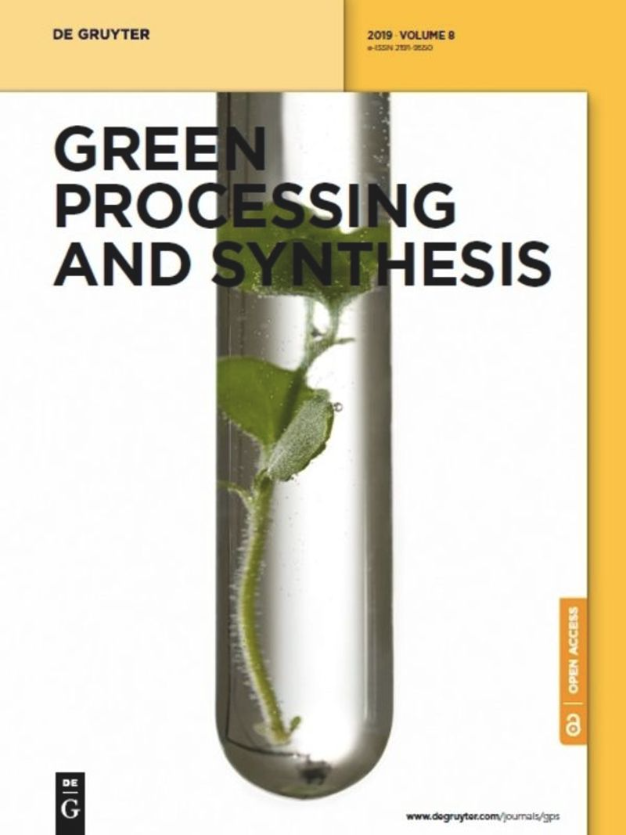pH和用量对紫外光制备生物金纳米粒子物理、化学和生物学特性的影响
IF 3
4区 工程技术
Q2 CHEMISTRY, MULTIDISCIPLINARY
引用次数: 0
摘要
摘要采用紫外加速技术制备了乌卤虫提取物,并将其用于金纳米粒子的合成。响应面方法用于评估提取物量的影响(2–8 mL)及其pH(6.5–10.5)对所制备的Au NPs的粒度、多分散指数(PDI)、ζ电位和抗氧化活性的影响。获得的结果表明,具有小颗粒尺寸的Au NPs(61 nm)和PDI(0.387),以及高ζ电位(−18.8 mV)和抗氧化活性(13.25%) mL所制备的A.urumiana提取物,pH值为10.5。将这些最佳条件用于Au NPs的合成,并评估了NPs的特性。结果表明,含有合成的Au纳米粒子的胶体溶液在562波长处具有宽的发射峰 nm。此外,透射电子显微镜分析表明,所制备的球形NP的平均粒径为25 nm。最后,评估了所制备的Au NPs对四种选定菌株的杀菌效果,即金黄色葡萄球菌、大肠杆菌、枯草芽孢杆菌和铜绿假单胞菌,结果表明,合成的Au NP对这些菌株具有较强的抗菌活性,其净区直径分别为16、17、11和17 mm。本文章由计算机程序翻译,如有差异,请以英文原文为准。
Effectiveness of pH and amount of Artemia urumiana extract on physical, chemical, and biological attributes of UV-fabricated biogold nanoparticles
Abstract Artemia urumiana extract was prepared and used in gold nanoparticles (Au NPs) synthesis via ultraviolet radiation accelerated technique. Response surface methodology was used to evaluate the effects of amount of extract (2–8 mL) and its pH (6.5–10.5) on the particle size, polydispersity index (PDI), zeta potential, and antioxidant activity of the fabricated Au NPs. Obtained results revealed that Au NPs with small particle size (61 nm) and PDI (0.387), and high zeta potential (−18.8 mV) and antioxidant activity (13.25%) were fabricated using 5.4 mL of the prepared A. urumiana extract with a pH value of 10.5. These optimum conditions were used in Au NPs synthesis, and NPs characteristics were assessed. Results indicated that the colloidal solution containing synthesized Au NPs had a broad emission peak at a wavelength of 562 nm. Furthermore, transmission electron microscopy analysis show that the fabricated spherical NPs had a mean particle size of 25 nm. Finally, bactericidal effects of the fabricated Au NPs were assessed against four selected bacteria strains, namely, Staphylococcus aureus, Escherichia coli, Bacillus subtilis, and Pseudomonas aeruginosa, and results indicated that synthesized NPs had strong antibacterial activity toward those, with clear zone diameters of 16, 17, 11, and 17 mm, respectively.
求助全文
通过发布文献求助,成功后即可免费获取论文全文。
去求助
来源期刊

Green Processing and Synthesis
CHEMISTRY, MULTIDISCIPLINARY-ENGINEERING, CHEMICAL
CiteScore
6.70
自引率
9.30%
发文量
78
审稿时长
7 weeks
期刊介绍:
Green Processing and Synthesis is a bimonthly, peer-reviewed journal that provides up-to-date research both on fundamental as well as applied aspects of innovative green process development and chemical synthesis, giving an appropriate share to industrial views. The contributions are cutting edge, high-impact, authoritative, and provide both pros and cons of potential technologies. Green Processing and Synthesis provides a platform for scientists and engineers, especially chemists and chemical engineers, but is also open for interdisciplinary research from other areas such as physics, materials science, or catalysis.
 求助内容:
求助内容: 应助结果提醒方式:
应助结果提醒方式:


